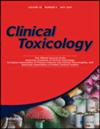向美国毒物中心报告的氯气和氯胺气体接触趋势。
IF 3.3
3区 医学
Q2 TOXICOLOGY
引用次数: 0
摘要
引言 当家用清洁剂混合使用时,可能会发生氯气和氯胺气体吸入。在 COVID-19 大流行期间,人们更加重视消毒方法,这可能导致美国氯气和氯胺气体暴露的增加,但尚未对此进行研究。方法在一项回顾性研究中,收集了 2015 年 1 月 1 日至 2022 年 12 月 31 日期间国家毒物数据系统中有关氯气和氯胺气体暴露的报告数据。数据包括人口统计学和暴露详情,包括地点、剂量、配方、共同暴露、治疗和结果。结果在研究期间,共报告了 85104 次氯气和氯胺气体暴露,包括 79281 次单独暴露和 5823 次共同暴露。总暴露量从 2015 年的 8385 次增加到 2022 年的 13503 次,增幅达 61%,其中 2019 年至 2020 年的增幅最大,达 38.3%。直到 2022 年,暴露总量仍在增加,没有恢复到疫情流行前的水平。大多数暴露发生在 "自己的住所"(n = 72,213, 84.9%),发生在家中的暴露比例在疫情流行前期高于疫情流行前期(88.4% 对 81.7%)。1%(n = 1,030)的暴露者被送入非重症监护病房,0.73%(n = 619)被送入重症监护病房,0.03%(n = 26)的暴露者死亡。在大流行初期形成的清洁做法很可能会持续存在,尽管日常工作已恢复正常,这可能是报告的暴露持续增加的原因。大多数报告的接触都是无意的,症状轻微,需要使用非侵入性疗法(如果有的话)。本文章由计算机程序翻译,如有差异,请以英文原文为准。
Trends in chlorine and chloramine gas exposures reported to United States poison centers.
INTRODUCTION
Chlorine and chloramine gas inhalation can occur when household cleaners are mixed. The increased emphasis on disinfecting practices during the COVID-19 pandemic may have contributed to an increase in chlorine and chloramine gas exposures in the United States, which has not been studied.
METHODS
In a retrospective review, reported data on chlorine and chloramine gas exposures in the National Poison Data System were collected from January 1, 2015, to December 31, 2022. Data included demographics and exposure details, including location, dose, formulation, co-exposures, treatments, and outcomes. Demographic analyses and descriptive statistics were conducted.
RESULTS
During the study period, 85,104 total exposures to chlorine and chloramine gas were reported, consisting of 79,281 isolated exposures and 5,823 co-exposures. Total exposures increased by 61% from 8,385 in 2015 to 13,503 in 2022, with the largest increase of 38.3% occurring from 2019 to 2020. Total exposures remained increased through 2022 with no return to pre-pandemic levels. Most exposures occurred in "own residence" (n = 72,213, 84.9%), with a larger proportion of exposures occurring at home peri-pandemic versus pre-pandemic (88.4% versus 81.7%). One percent (n = 1,030) of exposures were admitted to a non-critical care unit, 0.73% (n = 619) were admitted to a critical care unit, and 0.03% (n = 26) resulted in death.
DISCUSSION
The onset of the COVID-19 pandemic and increased emphasis on cleaning practices were likely contributing factors to the marked increase in exposures in 2020, which persisted through 2022. Cleaning practices that developed during the beginning of the pandemic likely persisted despite returning to more normal daily routines, which may explain the ongoing increase in reported exposures. Most reported exposures were unintentional, mild in symptomatology, and required the use of non-invasive therapies, if any.
CONCLUSIONS
Future efforts should focus on public education on the safe use of cleaning products to prevent exposure to toxic chlorine and chloramine gases.
求助全文
通过发布文献求助,成功后即可免费获取论文全文。
去求助
来源期刊

Clinical Toxicology
医学-毒理学
CiteScore
5.70
自引率
12.10%
发文量
148
审稿时长
4-8 weeks
期刊介绍:
clinical Toxicology publishes peer-reviewed scientific research and clinical advances in clinical toxicology. The journal reflects the professional concerns and best scientific judgment of its sponsors, the American Academy of Clinical Toxicology, the European Association of Poisons Centres and Clinical Toxicologists, the American Association of Poison Control Centers and the Asia Pacific Association of Medical Toxicology and, as such, is the leading international journal in the specialty.
 求助内容:
求助内容: 应助结果提醒方式:
应助结果提醒方式:


